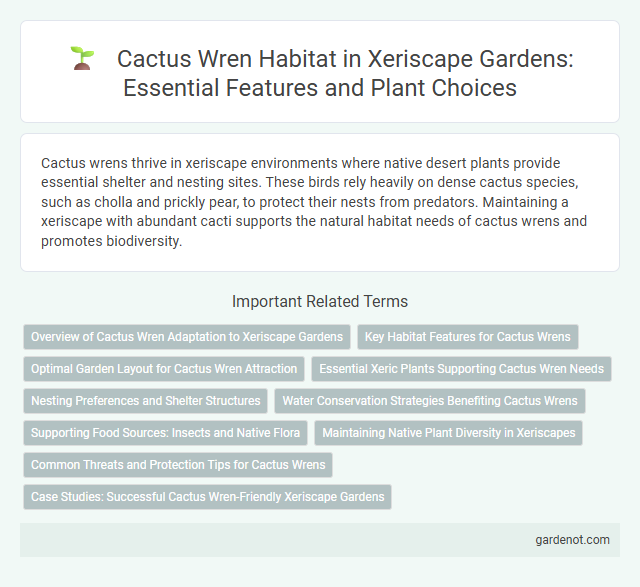Cactus wrens thrive in xeriscape environments where native desert plants provide essential shelter and nesting sites. These birds rely heavily on dense cactus species, such as cholla and prickly pear, to protect their nests from predators. Maintaining a xeriscape with abundant cacti supports the natural habitat needs of cactus wrens and promotes biodiversity.
Overview of Cactus Wren Adaptation to Xeriscape Gardens
Cactus wrens thrive in xeriscape gardens by utilizing native drought-resistant plants such as prickly pear and cholla cacti for nesting and protection. Their adaptability to arid environments allows them to exploit limited water resources efficiently while foraging on insects and seeds found in desert-adapted vegetation. This species' ability to integrate into xeriscapes enhances biodiversity and supports sustainable landscaping with minimal irrigation.
Key Habitat Features for Cactus Wrens
Cactus wrens thrive in arid xeriscape environments characterized by dense, thorny vegetation such as cholla and prickly pear cacti that provide essential nesting sites and protection from predators. The presence of large, mature saguaros offers critical perching and singing platforms, supporting territorial behavior. Sparse ground cover and open spaces nearby facilitate efficient foraging for insects and spiders, vital components of their diet.
Optimal Garden Layout for Cactus Wren Attraction
Designing a xeriscape garden to attract cactus wrens requires incorporating dense thorny shrubs such as cholla and creosote, providing ideal nesting sites and protection from predators. Strategic plant placement ensures open areas for foraging alongside sheltered spots for nesting and roosting, enhancing habitat suitability. Incorporating native desert plants with varied height and structure optimizes visual cover and food sources essential for sustaining cactus wren populations.
Essential Xeric Plants Supporting Cactus Wren Needs
Essential xeric plants supporting cactus wren needs include native drought-tolerant shrubs such as creosote bush, mesquite, and ocotillo, which provide crucial nesting sites and shelter. These plants offer a dense structure that protects cactus wrens from predators while supplying abundant insects for food. Incorporating palo verde and cholla cactus further enhances habitat quality by offering perching spots and additional nesting materials.
Nesting Preferences and Shelter Structures
Cactus wrens prefer nesting in desert environments with dense, thorny vegetation, especially cholla and prickly pear cacti, which provide protection from predators. Their nests, typically dome-shaped and constructed from twigs and grasses, are strategically placed within the cactus spines, enhancing shelter and camouflage. These birds often select nesting sites near saguaros or dense shrubbery to maximize safety and temperature regulation.
Water Conservation Strategies Benefiting Cactus Wrens
Cactus wrens thrive in xeriscape environments that utilize water conservation strategies such as drought-tolerant plantings and efficient irrigation systems, which preserve natural arid habitats. These birds benefit from the presence of native cacti and shrubs that provide both shelter and food sources while minimizing water use. Implementing mulch and soil amendments in xeriscape gardens further retains moisture and supports the insect populations vital to cactus wren diets.
Supporting Food Sources: Insects and Native Flora
Cactus wrens thrive in xeriscape gardens by relying heavily on native flora, such as mesquite and creosote bushes, which support diverse insect populations essential for their diet. These insects, including beetles, ants, and caterpillars, provide high-protein food sources critical for feeding both adults and nestlings. Maintaining a variety of drought-tolerant plants ensures continuous insect availability, promoting a sustainable habitat for cactus wrens year-round.
Maintaining Native Plant Diversity in Xeriscapes
Cactus wrens thrive in xeriscape gardens that prioritize maintaining native plant diversity, providing essential shelter and food sources such as native shrubs, cacti, and thorny plants. Incorporating a variety of drought-tolerant native species supports the wren's nesting and foraging behaviors while promoting a balanced, resilient ecosystem. Maintaining native flora in xeriscapes enhances habitat quality, encouraging biodiversity and sustainable water use in arid landscapes.
Common Threats and Protection Tips for Cactus Wrens
Cactus wrens face common threats such as habitat loss due to urban development and predation by invasive species like domestic cats. Protecting these birds involves preserving native desert vegetation, particularly large cacti like cholla and saguaro, which provide essential nesting sites. Installing cat-proof fencing and maintaining undisturbed natural areas supports the survival and breeding success of cactus wrens in xeriscape environments.
Case Studies: Successful Cactus Wren-Friendly Xeriscape Gardens
Cactus wren-friendly xeriscape gardens thrive by incorporating native plants such as cholla cactus, prickly pear, and creosote bush, providing essential nesting sites and food sources. Case studies highlight urban gardens in the southwestern United States where water-efficient landscaping techniques contributed to increased cactus wren populations by preserving their natural habitat. These xeriscape designs emphasize drought-resistant flora, minimizing irrigation while supporting the ecological needs of cactus wrens, promoting biodiversity in arid environments.
Cactus wren habitat Infographic

 gardenot.com
gardenot.com